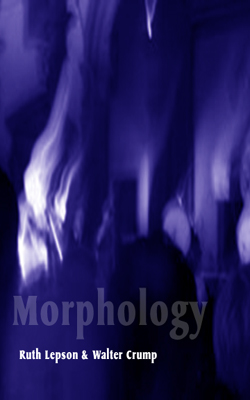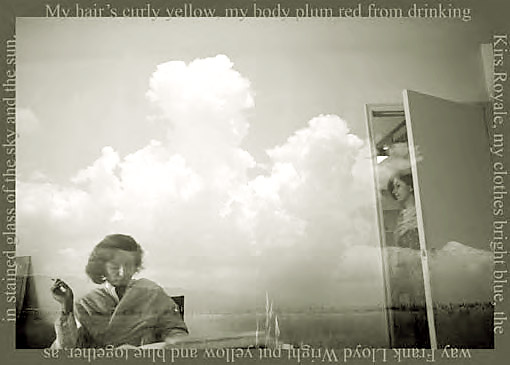
| Jacket 35 — Early 2008 | Jacket 35 Contents page | Jacket Homepage | Search Jacket |
The Internet address of this page is http://jacketmagazine.com/35/r-lepson-and-crump-rb-dooley.shtml
Ruth Lepson and Walter Crump
Morphology
reviewed by John Mercuri Dooley
(Design, Christina Strong) BlazeVOX Books, 2007 http://www.blazevox.org/bk-lc.htm
This review is about 4 printed pages long. It is copyright © John Mercuri Dooley and Jacket magazine 2008.
1
On the first page of this poetry/photography collaboration is what looks like an old photo of train track taken from a moving train, blurred as if a dream. The third page is an even more veiled image that echoes the curve of that track, but this time the curve is the sky. On the page between these two images: “Concepts and facts are drifting around in the air. One at a time they sizzle into fireworks. Then I can’t see them because they are inside me.” We don’t know where the tracks, sky, concepts and facts are going. They all seem to be drifting around in this wonderful book.
paragraph 2
The poems in Morphology are personal, but not in a confessional sense; we are looking into a diary of Lepson’s often-synaesthetic dreams, which accompany and are accompanied by Crump’s dreamlike images. Reading the poems, it feels as if Lepson is talking to each of us individually, engaged in an intimate and very comfortable conversation . . . about snow turning musical, floating marzipan and mascarpone, a sentence turning into molding on a building. It’s clear she enjoyed writing these poems, playing, and now sharing with us.

3
The writing is simple, calm and direct, and reminds me of the tone of Buddhist teachings, with a sense of humor. What’s funny is that we are talking about dreams, and Buddhist teachers want us to be doing anything but dreaming. They want us to be clear, and they might say, for example, When reading just read, or, When looking at photos just look at photos.
4
But Lepson, Crump, and designer Strong are saying, When reading dream, When looking at photos dream, When reading dream of photos, When looking at photos dream of words, etc. Buddha, concepts, facts and so forth drift in synaethasea. Dreams are seen as the flip side, or another side, of awareness.
5
Lepson makes me want to giggle sometimes, as when she says “all men are pencils, some serated like cardboard, some smooth, all are yellow and of varying length. Each man has to pick out a pencil that complements him.” This poem would work in prose form (as all poems in the book were written), but, as throughout the book, it says more thanks to Strong’s typography. She designed the poem around enormous “y”s in “yellow” and “varying”.
6
Lepson often comments on language, filtered through dreams: “Celia’s standing inside a huge paragraph, the words the size of humans. She’s situated in front of the sentence in the middle; someone else is standing at the end of the sentence,” and “Sentences are colorful scarves people wear to warm themselves” and “One day there will be no more popcorn, no more words, no more pictures.” So it makes sense that the design comments on language too, by, for example, drawing attention to letters.
7
Strong’s design is so entwined with the material of the poems that she is, in my eyes, an equal collaborator. It’s no surprise she is a poet. In “all men are pencils ...” the large “y”s create their own image on the page; a sort of concrete poem is superimposed on the prose poem. She matches Lepson’s playfulness. Also, in this poem, Strong chose to emphasize an important element in Lepson’s dreams/poems–color.

Photo © Walter Crump, used with permission
8
Crump calls his way of working with photography “controlled accidents.” He uses cylindrical pinhole and anamorph cameras for some of his photos because, he says, they warp the world. Since these cameras don’t have view finders or light meters, the photographer doesn’t know exactly what is being photographed or how a photo will look. Some of Crump’s photos include images superimposed on other images, and he extends this idea in Morphology by adding another layer to his photos, in the form of Lepson’s words.
9
For example, the words “curving” “words” and “into colors” curve over rocks in a photo taken at the seashore. Crump also uses Lepson’s words as graffiti on the sides of buildings (“I see the world is made of language, everything is”), as writing in the sand at the beach, as marks or shapes imbedded, and sometimes hidden, within images. In this book, his diaphonous pictures align with Lepson’s dream text and Strong’s often whimsical typography to create a sensitive, well thought out whole.
10
Morphology brings up an important issue in contemporary publishing, that of print-on-demand (POD) books, and books available to read online in PDF versions (the book can be ordered from the BlazeVOX Web site in POD format, or on the Web site in PDF format; it is not available in bookstores). Some see these options as a godsend for small poetry presses, and others think they should be damned.
11
The easy availability afforded by these publishing developments, one argument goes, allows anyone in the world with access to the Internet to read obscure books, and of course this is a good thing. Also, small presses have a greater chance of survival if they do not have to finance print runs. Detractors say poetry is only properly considered as it is encountered in a physical object, the book, and that the quality of print-on-demand does not match the quality of conventional publishing ventures.
12
True, the experience of holding a book in your hands, reading actual pages, is a richer one than looking at a computer screen, but the benefits in distribution and availability can’t be dismissed. In these times, when fewer and fewer people read anything, and poetry even less, and when small presses struggle to survive, POD and PDF poetry books are welcome.
13
There is something to be said for, and against, both forms of Morphology — POD and PDF. Most importantly, the reproduction of the photos in POD books is generally not very good. This book is no exception: the images are too dark, so you can’t see all the nuances of Crump’s overlaid images. This is especially unfortunate in a project in which layers of reality/dream are central. Online, you don’t miss anything in the photos.
14
On the other hand, looking at the book, you are more aware of each pairing of poem and photo facing each other on separate pages, and all the white space on the facing pages that creates a field for the paired image and text. Since Morphology is a visual project, you are missing something if you do not see this relationship of left page to right. Also, creating relationships between photos and poems was key to the project, and it’s good to see these intended relationships clearly. With the PDF version, you see only one page at a time, so you don’t make these same visual, intended, connections.
15
As a reader/viewer, online, you make relationships between photos and poems yourself, and this in itself is satisfying. You decide, or don’t decide what goes with what, and maybe this changes with each viewing. Is one image to be paired with the text that follows it, or the other way around, or both, or neither?
16
My advice is to go online to look at the photos but for a greater appreciation of Morphology get the book. Holding a book is a more restful experience than looking at a computer screen, and restfulness seems right for this work from Lepson, Crump and Strong.
John Mercuri Dooley’s poetry has appeared in Blaze Vox, facsicle, Gut Cult, Moria, Word For/word and elsewhere. MuBet, and ongoing project, can be seen at http://www.mubet.net/ With his husband, Andrew Richardson, he curates the Demolicious Poetry/Multimedia Series (http://www.demolicious.net/) in Cambridge, Mass., U.S.A.